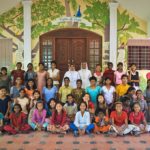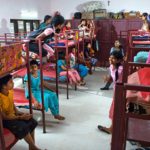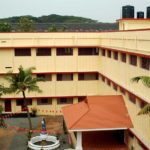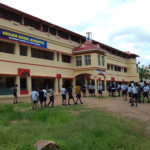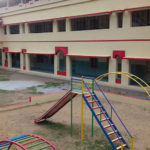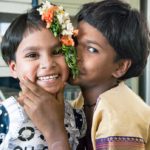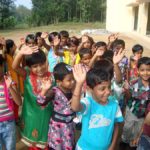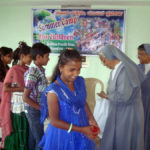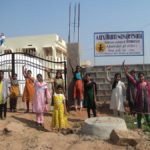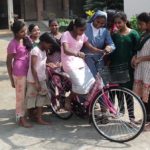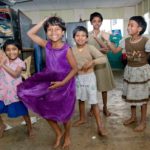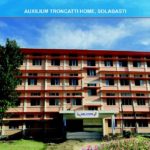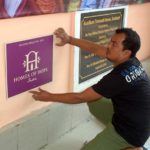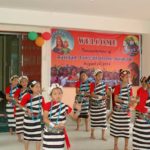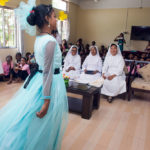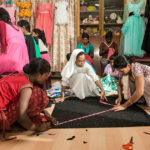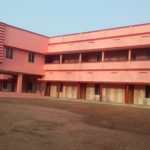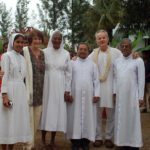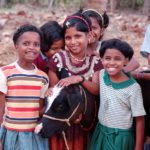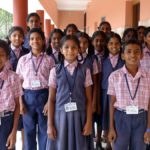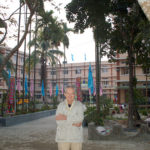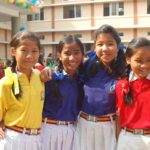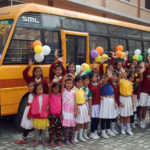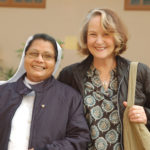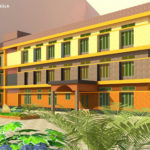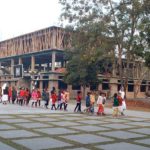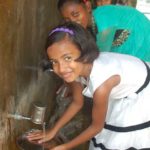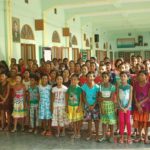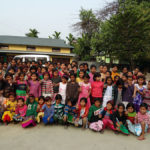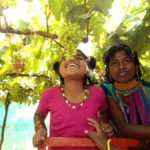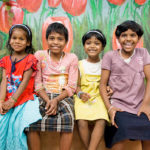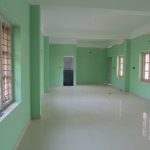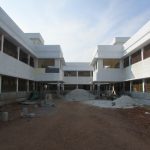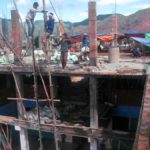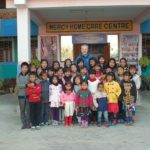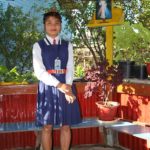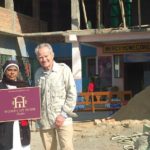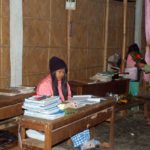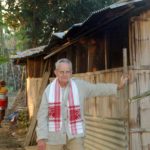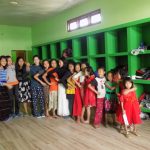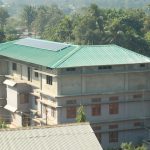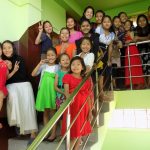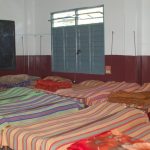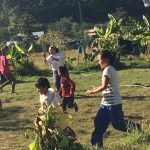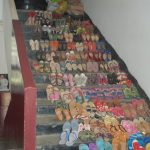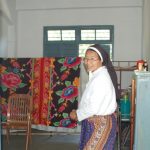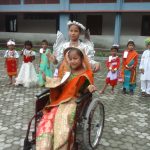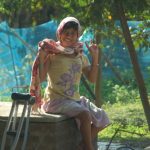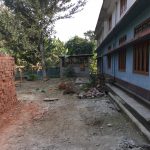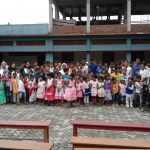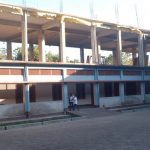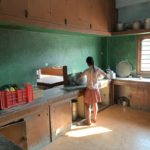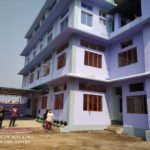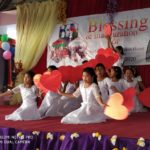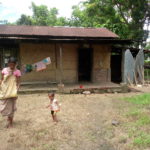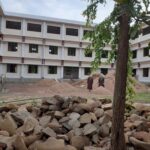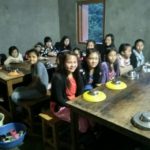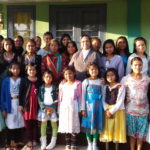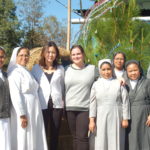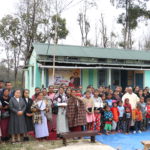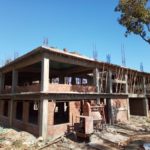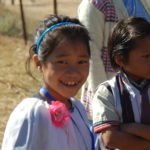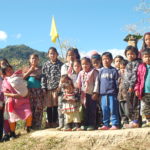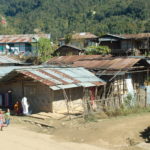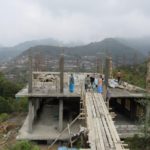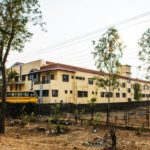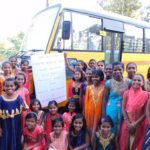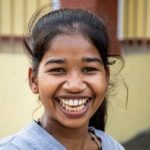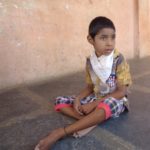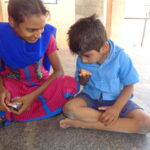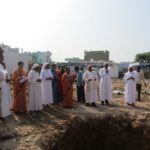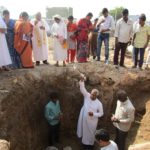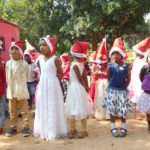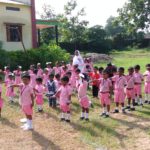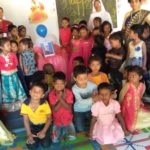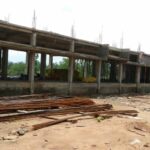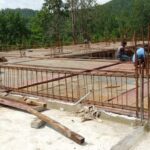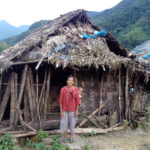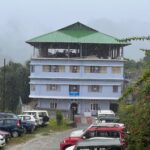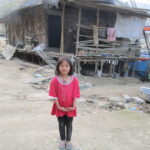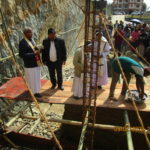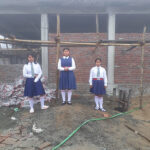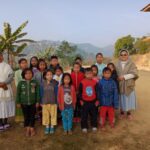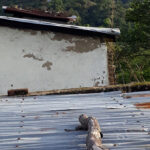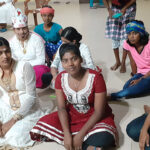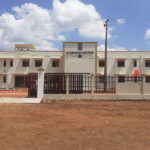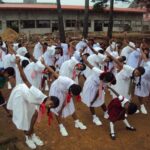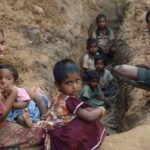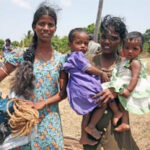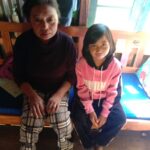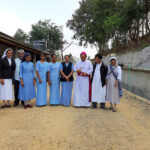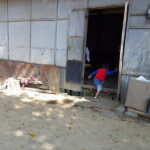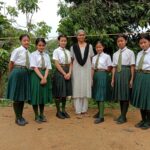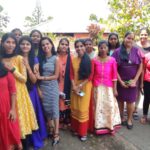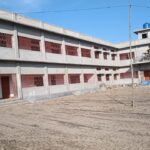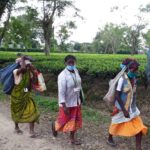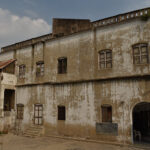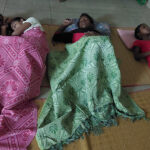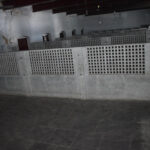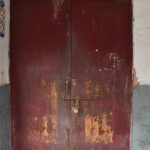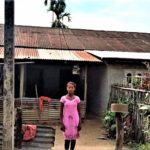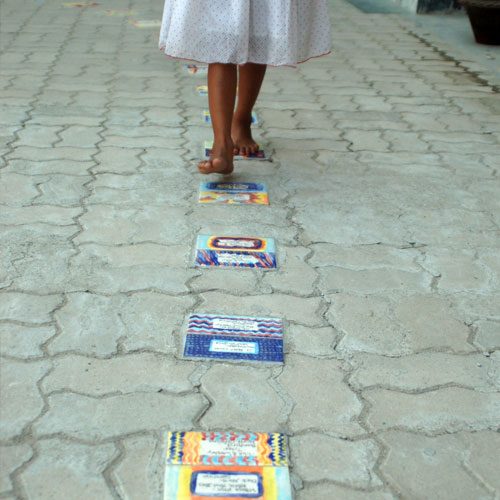We Build Orphanages….and Save Lives
Throughout India, Homes of Hope has transformed the lives of thousands of orphaned, abandoned, and trafficked girls.
We have rescued girls from the horrors of the street. In our Homes of Hope they are loved, fed nutritious food, they go to school. They are able to regain their childhood as well as prepare themselves for the future. Girls who once came to us in ragged clothes and sadness in their souls are now nurses and office workers, fashion designers and computer programmers. They have broken the cycle of poverty.
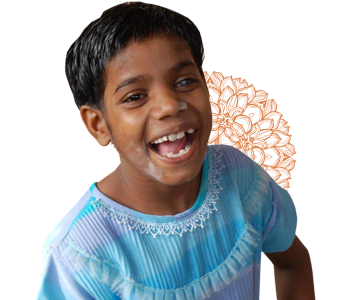

Take this tour of our Homes of Hope and see what we have done together.
Click the names below to learn more…
Kochi is a large commercial center in Kerala. It is often a destination for those from more impoverished areas of India; children are often found begging on the streets, in train stations and bus stands. It was here at a poor orphanage named Prathyasha Bhavan that I found Reena, a tiny six year old. Her eye had been cruelly gouged out to make her a “better beggar” for the unscrupulous “beggar mafia,” who maim these little ones to make them more pitiable as they beg for them. When I heard her story, I was horrified and it showed on my face. Reena returned that look of horror with a lovely, trusting smile and it is that smile that launched our work in 2006. I promised to do something to help Reena and her 60 friends at Prathyasha Bhavan. I didn’t know what, but I just couldn’t walk away.
At first, I thought mattresses were the answer as the girls were sleeping on a concrete floor. I raised money from friends for that, but soon realized what they really needed was a completely new building. It was tough sledding as I had no organization, not even a name for what I was trying to do. As Prathyasha Bhavan translates to Home of Hope, I started a nonprofit in that name. I started begging. First to friends, then to anyone who would listen. I also had the chance to be a mission speaker at Catholic parishes. Twenty dollars here, a hundred there, and over three years somehow enough was raised to build a new home for Reena and her friends.
Today our Kochi Home of Hope is a three-story residence, containing dormitories, a modern kitchen and refectory, study areas and computer room. Some of the girls are orphans, others were abandoned by parents who could not care for them, still others were neglected or were victims of sexual exploitation. Some of the girls attend the Salesian sisters’ English medium school on the grounds; the others go to nearby public school.
Capacity: 100
touch/click any photo to enlarge
Although I envisioned Homes of Hope primary mission as building orphanages, it was soon apparent as I traveled to India that education was another critical need. Only through education can marginalized children break the cycle of poverty. Kochi and Secunderabad already had good schools for the girls to attend.
First we had to change our name; we were about to expand our focus.
Maradiyur is an impoverished village between Bangalore and Mysore and the Salesian Sisters of Don Bosco, our partners in our first seven Homes of Hope, wanted to create a school and rural empowerment center for the local villagers. As I walked among the simple, one room concrete block homes, and saw the many children there, I agreed we would spread our arms wider, to embrace them.
Today at Maradiyur we have a pre-K-8 school housed beautiful two-story building, bringing pride to a forgotten community. Through the education of poor children, both boys and girls, and providing medical and social work assistance for families in need, Maradiyur will thrive.
Capacity per year: 350 Students
touch/click any photo to enlarge
Just as Kochi was being dedicated and I thought our work was done, a Home of Hope board member called from Secunderabad, where he was visiting on business. “It’s worse, Paul,” he said, “Salesian sisters here have more children, terrible conditions, crammed into a tiny building, sleeping on an even worse concrete floor.”
Secunderabad and its twin city, Hyderabad are also where many poor families come in search of work; children are lost, abandoned, parents die. So we launched a second drive, to build a home for these girls, in the Uppal District. A good number of our first donors stayed with us. I found new donors through parish talks. This proved to be a tough one, as local official kept “losing” our documents and delaying building permits. After many bureaucratic setbacks, Secunderabad would become the first LEED-certified, environmentally friendly, orphanage in the world.
We support not only the new building in the Uppal district, but the original home at Bhoiguda, where the girls were found, and a smaller orphanage at Mahindra Hills, where we also help support a school.
Total capacity 120.
touch/click any photo to enlarge
Our first three Homes of Hope were constructed in partnership with the Bangalore Province of the Salesian Sisters. I now began to search other areas in India where Homes of Hope might provide buildings that could uplift children and transform communities. I found plenty of need in Northeast India, which is one of the poorest sections of the country. There the Salesians based in Guwahati, Assam, saw a specific and pressing need: to build a training centre in a remote tea-growing area that would provide short-term residency and practical training for girls. Without this training in sewing and fashion design, as well as computer and office skills training, the girls would be consigned to the fate of the generations of women before them: pitifully low wages ($1.50 a day) picking tea.
With Solabasti, we were able, once again, to work exclusively with girls. If you are a female in too many parts of India, you are considered a second-class citizen, at best. In this male-oriented society, gender discrimination is rife. I was happy to be back on track, working to help marginalized girls and young women.
Today our beautiful, well-equipped, four story centre at Solabasti is a beacon of hope. Hundreds of girls have been trained and have found jobs because of the skills they have learned. And new classes come in twice a year, bright-eyed young women ready to chart their own lives
Capacity: 120 per year
touch/click any photo to enlarge
Homes of Hope was beginning to be better known. When generous benefactors expressed interest in specifically supporting the construction of a school building, we knew of such a need in the Josephnagar district near Hassan, which is also between Bangalore and Mysore. I had visited this rural location before where the sisters already had a hostel for 70 girls. However, the local government schools were terrible.
In this poor village both girls and boys now have access to an excellent school, pre-K-10. Not only were we able to help in building the school, we were able to find other donors to provide what any good school needs. We have a computer lab, a language lab and science lab with modern classrooms where young students can prepare for productive lives and even higher education.
In each location, we were determined not just to provide a roof over their heads (a good start, to be sure), but to provide clean drinking water, sanitary facilities and whatever children needed to give them a solid foundation in life.
Capacity: 300 students
touch/click any photo to enlarge
In the area around Kokrajhar, Assam, ethic fighting had disrupted the lives of far too many families. With villages burned to the ground, parents killed, hundreds of girls languished in squalid refugee camps. These girls needed a safe home, the opportunity to go school, to regain their childhood.
When I first visited Kokrajhar, the children and sisters greeted me, standing in knee-deep water. The grounds had flooded, again. Food and supplies had to be rescued; children were jammed together in those rooms that were not flooded. This was a no-brainer!
As the sisters would call it – a “Mighty Building” – rose on the very site of the flooding. With proper grading, floodwaters were diverted. Kokrajhar was our largest Home of Hope thus far.
This huge four story building has (as do all our homes) study rooms, a computer lab, sanitary washing facilities, and a beautiful chapel, where girls of all faiths can be at peace with their Maker. Across the street is an excellent school, so Kokrajhar provides all our girls need to make the very most of their lives.
Capacity: 120
touch/click any photo to enlarge
When I first visited Tangla, also in Assam, I was appalled at the conditions. (I was getting used to this, but it was exactly the kind of outrage that spurred on Homes of Hope and brought even more donors and more urgency for our work.) What these poor kids in India had to tolerate! The girls were crammed into classrooms in a school with no room to store their few articles of clothing. The bathing and sanitary facilities were dismal and unsanitary. Just think about taking care of all those daily needs in a school bathroom. The brave Salesian sisters were doing the best they could, but a new home for these girls was badly needed.
We moved ahead quickly. Each summer Homes of Hopes representatives were able to speak in Catholic parishes and report what we had found in India. Parishioners across the country resonated to our message. Each Christmas season we started what would be our one and only fundraising appeal, highlighting our latest project. At first donations were modest, but then, they grew and grew. It was only as I look back that I see how each year we raised more funds than the last.
Tangla today has a bright new structure, standing out from the lush tropical terrain, providing simple but clean dormitories, sanitary facilities and study rooms so our girls can excel in the school that is just across the courtyard.
. Capacity: 100
touch/click any photo to enlarge
Bangalore is India’s primary IT center. Nevertheless, amidst the glittering glass and steel offices for Google, IBM, and Amazon there is grinding poverty. Impoverished families stream to Bangalore, seeking work. Children beg in train stations and bus stands and on the streets.
With four smaller houses already overcrowded in a densely populated urban area, the Bangalore Province Salesians badly needed more room to take in more street girls. They were fortunate to find a former vineyard in the Devanahalli district, on the way to airport, and here a Home of Hope would be home to many more girls.
At our newest Bangalore home, girls will have a chance to run, play and breathe clean air. They will study in the quiet of the countryside and prepare for a real future. What a wonderful change from the crowded, dirty inner city.
Capacity: 100
touch/click any photo to enlarge
We were about to go further into Northeast India.
Churachandpur is approximately 60 kilometers from Imphal, the capital of Manipur. It is one of the poorest districts in the state. Because Imphal is on a trucking route, it has seen an epidemic of HIV transmission; it has one of the highest rates in India. Franciscan Clarist sisters were doing parish work there, but as parents died of AIDS, they took in one orphan, then another and eventually found the need to care for orphaned and abandoned girls required their full attention and a new location. We discovered the sisters’ plight in 2016 when they had stopped construction on a much-needed building after exhausting what little funds they had.
We immediately told the sisters to call back the construction crew; the Homes of Hope family would help you complete the building. This would be our first project with Franciscan Clarist sisters, a religious order indigenous to India, which combines the spirituality of St. Francis and his sister, St. Clare.
Mercy Home at Churachandpur is now home to girls who have lost their parents to AIDS. Some of the girls were born HIV-positive, and under the sisters’ care, they receive appropriate anti-viral drugs. This beautiful building has a rooftop shelter where the girls can play and have programs (and dry their clothes) during the rainy season. We are also providing solar-powered electricity, and a complete water harvesting, storage and purification system to provide year around clean water.
Capacity: 50
touch/click any photo to enlarge
When I visited India in January 2017, I would find that Dimapur, Nagaland, was the very epicenter of the AIDS epidemic. Here, it was even worse than at Mercy Home at Churachandpur, Manipur — an astounding infection rate of 1 in every 113 people. I vowed we would stand side by side with a brave group of Carmelite sisters I had found who were struggling to take care of the children of that scourge, children orphaned by AIDS.
A sagging bamboo shelter at Chavara Home had served as a “temporary” home for a group of young girls, from 6 to 17 years old, girls the sisters were caring for as best they could. The shelter was pitiful, ten years old, the roof leaked and it was bitterly cold in the winter months. Almost half of the girls were HIV-positive; it was easy to see that the conditions were woefully inadequate for girls whose immune systems were already compromised.
During that visit, when I told the girls that Homes of Hope would help to build them a new home, you can just imagine their excitement. Seeing their bravery, I knew we had to do everything we could to make their lives better. This would be our first project with the Carmelites, our third congregation of nuns, and the Homes of Hope family immediately started raising the needed funds.
Two years later, the girls would have a bright new home to call their own, with a real dormitory, real beds and sanitary facilities. Homes of Hope also added an activities building, which has a study hall with computers, an assembly area to stage plays and practice traditional dances, and a kitchen/dining area. You cannot imagine the looks on the faces of the girls when they sat down at a table for the first meal. No more eating on the floor! You will note solar panels on the roof – they produce most of the electricity for the house. We believe in taking care of our girls and taking care of the planet. We are sustainable in more ways than one!
Capacity: 50
touch/click any photo to enlarge
Walking onto the grounds at Carmel Jyoti orphanage in Imphal, Manipur, you could just feel the warm and loving home the Carmelite Sisters had created for the children who live there. Girls skipping rope, sisters gathering greens for the evening meal, cows grazing peacefully in the field that doubled as a soccer field. A beautiful Indian sunset lit the late afternoon sky.
But there was a not-so-small problem at Carmel Jyoti: there was no permanent place for the 65 children to stay.
They were living in horribly crowded conditions, jammed into the classrooms of a school. Each morning they rolled up their thin bamboo mattresses, swept and mopped the floor before desks and benches were pulled into place. The schoolchildren would be arriving soon; they had to hurry. They all shared a single bathroom, in an outside shed. When a child was sick, a makeshift infirmary was tucked into a hallway, beneath a stairwell.
Most of the children were AIDS orphans, some were HIV-positive themselves. They had been abandoned, often turned away in their villages, for fear they would infect other children.
This is where Homes of Hope came into their lives.
In early 2018, Homes of Hope began working with the sisters and a generous Utah foundation to build a dormitory for the girls, along with a properly outfitted infirmary, water harvesting and water storage system. We added a new kitchen, dining hall, in-door study hall/recreation area and playground.
As with all Homes of Hope, we build not only in the present, but also for the future. We doubled the capacity of Carmel Jyoti; no girls in need in this area will ever be turned away.
Capacity: 120
touch/click any photo to enlarge
When we found Alphonsa Home in late 2017, we could not believe how the brave Franciscan Clarist sisters had coped so long and so well with so little. In their small school building – which served as school during the day and dormitory at night — they actually had to physically carry other-abled children up and down the stairs each day.
Going from village to village near Bongaigaon, Assam, the sisters had taken in society’s “castoffs”, children living with disabilities and conditions such as autism, cerebral palsy and deafness, children who were blind, those with malformed limbs. They found children who had been orphaned by AIDS and others living with a poor single parent, who, because the child’s stigma and poverty, had never been to school.
There are no government schools or social service support for children living with disabilities in this part of India. Girls especially are marginalized. Often they are kept at home, alone, or have to look after their younger siblings while parents go for day labor. Parents are embarrassed to expose their children to others so they hide them.
Knowing the generosity of our Homes of Hope family and seeing this critical need, in early 2018 we began construction on a three-story building – before we had raised the first cent!
In early 2020, we finished a beautiful, spacious building that uses the open third floor for activities and future expansion. We provided a ramp so children with physical differences can make their way to the second floor, a sensory garden for autistic and blind children to stimulate their awareness of the world around them, and a water harvesting system to provide fresh drinking water throughout the year. There is a physical therapy room, computer room, study area and chapel, everything the children need to live up to their highest potential, so they can lead a happy, healthy life.
Capacity: 100
touch/click any photo to enlarge
As a group of four Salesian sisters in Imphal, Manipur worked with women addicted to drugs, their hearts were broken at what these women were going through. Homeless, sometimes HIV-positive, many had turned to prostitution to feed themselves and their children. Banished from their families, they had no one to turn to. First one, then another came to live with the sisters.
Young unwed girls who were addicted and pregnant and had undergone treatment had nowhere to go back to except the streets. As women died from AIDS and others who could not care for their babies gave them to the sisters, the Salesians found their small convent/home had actually turned into an orphanage.
The situation was grim when we heard about the sisters’ plight in early 2019. The 53 girls in their care were living on a narrow terrace, sheltered by a battered roof. It was a dormitory and study area, recreation space and closet for their few clothes. It was the best the sisters could do. The alternative was to turn them back to the streets and that was not an option.
With proper medical care and a loving environment, marginalized children and AIDS orphans can thrive. In the twenty years the Salesian Sisters have worked in the area they have seen remarkable progress in children who once were isolated and banished from society. However, they first needed a proper place for the girls to live.
With the help of a generous benefactor, we completed Sneha Bhavan, Home of Love, in early 2020. What a change! Our girls are now able to sleep, live, study and pray in a calm, bright, communal setting. They are preparing for an independent future. They will have the continuing support of the sisters, even after they leave Home of Love, and begin their first jobs. That love continues as they marry and have children of their own.
In addition, Home of Love – like every Home of Hope – makes a statement to the surrounding community: every child has value and worth and with proper nurturing can achieve and thrive. Furthermore, the presence of Catholic sisters makes a powerful evangelical statement of God’s love for the poor.
Capacity: 80
touch/click any photo to enlarge
Darogajan is a small rural village some 20 kilometers from our #10 Chavara Home of Hope in the major city of Dimapur, Nagaland. It is an area that has seen families torn apart and driven from their land by ethnic unrest, an exploding AIDS population, and the corrosive effects of grinding poverty.
Girls in India are especially marginalized, so they are the last to receive decent food, education, medical attention. They are prey to sex traffickers who continually prowl this area, offering parents a small amount of money to allegedly place their children in a good paying job. At best, it is domestic slavery; at worst prostitution. Girls as young as 6 or 8 have been lured into degrading lives.
When we sent a Homes of Hope team to visit Darogajan in the fall of 2018, they accompanied a group of Carmelite sisters and a group of girls to a bare parcel of land. It did not look like much, covered with weeds and overgrowth, but the sisters could see something else. The sisters had worked in this area for decades and were already sheltering some 30 girls in makeshift, crowded housing. For years they had dreamed of a real home for their girls and other village girls who were living in similar deplorable situations.
Their dream was about to come true.
With the help of a generous foundation, we broke ground on #14 Home of Hope in early 2019 and by the end of 2021 the girls had a new, safe place to live. Here they will receive a first rate education and good nutrition. They will be healthy, both physically and spiritually, in the sisters’ loving care. When they leave, they will have the tools and confidence to navigate life beyond these walls.
Capacity: 100
touch/click any photo to enlarge
In Khapmara, a small, undeveloped village 40 kilometres from Shillong, most families eke out a living by hiring themselves each day. Men, women, children, as soon as they are old enough to work. They are paid a maximum of $3 for hours of backbreaking work. Most are “tribals,” members of various indigenous tribes, among the poorest and most marginalized people in India. They face discrimination on a scale similar to the Untouchables.
As we learned over the years, girl children are especially vulnerable. They are educated less, if at all; fed less and daily face sexual harassment. In addition, in this area of Meghalaya in Northeast India, polygamy is practiced. When a poor man takes on the next wife, the previous wife and children are often neglected or abandoned entirely.
It is a common practice for a poor single mother, in desperation, to trade a daughter for a cow. The cow will sustain the other members of the family; the girl will be an indentured servant. Other girls have been bargained into a life of prostitution by unsuspecting parents who are duped into thinking their girls will get real jobs.
A Salesian sister working in Khapmara contacted us in late 2018, asking help to build an empowerment centre. Although we would have to again widen the reach of our mission – to concentrate on uplifting tribal girls – it did not take long to convince us. This was a critical need and we could help transform lives and communities by building a structure that would serve two different purposes.
For younger girls, it will be their home so that they can go to a regular school. Older girls 15-20 years old, are considered “dropouts” in India, but in reality they never had a decent school to drop out from. If we did not help them, they would soon be pregnant, married and the cycle of poverty would spin on. For those girls it will be a temporary home while they receive six to eight months of vocational training that will prepare them for a job.
Girls will be trained, according to their ability, in computer use, health care, business administration, office management or tailoring. They would then be eligible for real jobs instead of low-paying fieldwork, or have skills to make them self-sufficient. And they would not be forced into an early marriage. Or traded for a cow!
Capacity 100
touch/click any photo to enlarge
Arunachal Pradesh is in one of most rugged parts of Northeast India, mountainous with marginally arable land. It is also one of the poorest, with many indigenous tribes that live at subsistence level, often as day laborers. People live in small, isolated villages like Mengio, where we found a group of Missionary Sisters Servants of the Holy Spirit struggling to help the local population.
This would be our first project with the Holy Spirit sisters (we were now working with four congregations of women religious) who had a small school, but no place to keep the tribal girls from far-flung small villages. If the sisters did not intercede, the girls would not be educated and would either become pregnant or forced into early marriages. When we found the sisters, they were housing 60 girls in rickety bamboo structures.
With the help of a generous couple, we were ready to help, but Mengio presented a unique problem: the land is so mountainous that the sisters would have to literally shave off the top of mountain to prepare level ground for the building. No problem, the sisters told us. They were used to living in this rugged terrain.
As we learned more about this area, we found that certain tribes are considered “slaves” of other tribes, either by tradition or because they are beholden to them for the means of existence. The girls of “slave” tribes had little control over their lives and could be bargained away for a small sum of money or a cow or forced to marry in order for a family to survive.
Girls were additionally victimized in the villages around Mengio as polygamy is practiced here; two, three, or four wives are not untypical. As the man moves on to his next marriage and the next, the children left behind are considered “semi-orphans,” as their main source of income is gone and they are further plunged into even deeper poverty.
We could see clearly that there is only one way to stop this cycle of poverty and early marriage and it is through education and mentoring at the hands of the Holy Spirit sisters. So the mountaintop was shaved off and a new building took shape. Our girls will happily move into their new quarters in time for the 2020 school year.
Capacity 80
touch/click any photo to enlarge
The region north of Mumbai is the homeland of many indigenous aboriginal tribes (again, think Adivasi, Dalit, or Untouchable.) They make up 63% of the population. Of these, a tribe called the Warlis make up more than three fifths of the tribal population.
The Warlis live on the once a year cultivation of their tiny plots of land and day labor, when it is available. They are poor, predominantly illiterate, with poor health and hygiene. The Salesian sisters working with the Warlis in the village of Khedpa, Maharashtra, saw that they had little self-esteem and sense of self-worth. Politically they are marginalized and not represented. They live in bamboo and mud shacks, a “sub human life”, as the sisters told us.
The Mumbai province sisters first organized women in self-help groups and taught them to take care of themselves and their neighborhoods. Contagious diseases like dysentery and cholera are endemic here; there are also cases of leprosy. The sisters taught health and hygiene, preventive and curative health, and safe preservation of drinking water
The sisters knew that the girls and young women needed education, in tandem with personal mentoring and support if they were to thrive and create sustainable changes in their personal life and communities. They wanted to build the girls’ dignity and self-worth, so they might become change makers and peer educators and overcome their poverty and low status in life. Providing quality education was the only way to bring up the status of this tribe from the vicious circle of poverty.
Although the Salesians had started a building, they soon ran out of funds. In early 2019 Homes of Hope discovered the needs of this area and immediately promised to help complete the building. It would be our biggest project to date.
With the building completed in early 2020, the sisters can now educate 200 Warli girls every year. Younger girls attend regular school classes and older girls pursue vocational training according to their aptitude and interest. They will take courses that will qualify them as nurse assistants, office workers, tailors, and IT operators.
They will escape the cycle of poverty and live dignified lives. Their communities will see them as examples of how education and life with the sisters can set women on new and exciting paths in life. Other girls will follow in their footsteps.
Capacity: 200
touch/click any photo to enlarge
In a letter I received in 2018 from the Sisters of St. Anne, I read about their work in Rentachintala, a poor village in Guntur district of the Indian state of Andhra Pradesh. Due to lack of anything approaching even marginal education, the mentally, physically, visually and hearing impaired children in the area were horribly neglected, sometimes even cast out by their families. They could never compete with others in school would never find any kind of employment.
Many of them were teenage girls who were left on the streets or outside their homes without any protection. These girls were experiencing physical and emotional abuse at the hands of predators but were unable to convey their plight to their family members or others. Girls were raped and did not understand what had happened.
When I found that two of the sisters were about to pay a visit to the United States I invited them to come to my home in Wilmington, North Carolina, to tell me more. They didn’t need to be too convincing: to think of these girls being abused at the hands of predators was more than I could stomach.
The proposed building project will realize the dreams of the sisters. Over the years ahead, thousands of mentally, physically, visually and hearing impaired girls will be helped. They have potential and in this, our second home for other-abled children, we would help the sisters work with the girls to realize it.
It would be our first project with the St. Anne sisters. Our other partners, all religious orders of women, are the Salesians, Carmelites, Franciscan Clarist and Holy Spirit sisters. Homes of Hope has purposely worked exclusively with certain Catholic orders of religious women because their focus was our focus: to help marginalized girls and young women. Rentachintala aims to provide education and teach living skills and to provide a hostel for 200 mentally, physically, visually and hearing impaired children.
While Sister Anthonamma and Sister Paul Tresa were here in Wilmington, I didn’t want to make their visit all business. As you see in the photos, they had a chance to wiggle their toes in the sand at Wrightsville Beach and to enjoy a specially-made sandwich at the Which Wich owned by an Indian local friend.
Capacity 200
touch/click any photo to enlarge
The village of Kurtumgarh in the Indian state of Odisha west of Kolkata (Calcutta) was the center of horrible violence when communal riots broke out in 2008-09. Many lost lives, over 5,600 houses were torched, and the poor Dalits and Tribals who lived there were driven from their homes. A few years later, the danger past, villagers slowly returned from their hiding places in the forests.
In 2016, three Salesian sisters from Kolkata (Calcutta) made the arduous 18-hour journey to settle in Kurtumgarh and begin to help the people put their lives together once more. Though most of the villagers are day labors and illiterate, they were aware of the need for education if their children were to have a better life.
Homes of Hope visited Kurtumgarh in early 2020 and found that the sisters had started a small school in vacant shed near a local parish. This a classic approach we have seen before: sisters start a small school for young children, win the confidence of the villagers, and hope that the funds would be available someday to build a real school and hostel.
We were taken by the bravery and kindness of these pioneer sisters and promised to help them construct a building that is one part school, one part residence for girls and staff sisters.
Construction is temporarily halted over a land dispute.
Capacity: 100
touch/click any photo to enlarge
It is hard to believe that slavery is still practiced in some parts of India.
When we met Franciscan Clarist sisters in Itanager, the capital city of Arunachal Pradesh in Northeast India, we could hardly believe what we were hearing. They were working with the Puroik tribal people whose children were forced to work in the fields of the “master” and whose young daughters could be sold off as brides as young as 10 or 11. Because of their isolation, poor schools, and lack of any hope for the future, girls become pregnant at an early age, with or without marriage. As men moved on to another, younger wife, single mothers and children were left behind in even more abject poverty.
The sisters had identified many young Puroik girls in villages outside of Itanagar whose mothers wanted a better life for them, but there was no place for them to stay while they went to school in the capital city. We immediately knew it was a perfect place to build a Home of Hope — but we were still raising funds for earlier projects.
By the beginning of 2020, we finally found our way clear to help and began construction on a Home of Hope. It is now home for 40 Puroik girls under the age of 15, giving them the opportunity to go to school. They receive a first rate education and are learning that they have control of their lives as they prepare for a sustainable future and employment. They will become role models and change-makers in their communities and other young girls will see the power of a good education – that no one can take away.
Capacity: 40
touch/click any photo to enlarge
In June, 2020, we received this message from an order of Catholic nuns we had never heard of: Missionary Sisters of Mary Help of Christians. But the message and photos they sent were so compelling, we had to help them.
“Temporary building all broken down, even after repairing many times. The orphans, HIV/AIDs children have no proper place. They are kept in a small building along with sisters. The small building is made of tin roof whenever it rains, it is leaking. Every time the strong wind blows off the roof. Some of the roof tin is held down by putting big stone or log on the top of the roof to avoid roof to be taken away by the wind. When rain and wind occurs all the water is inside the house. Therefore a new building is urgent need, So that our Orphans and HIV/AIDS patients can have better care and provide them all round development especially on education with your kind help.”
In communicating with the sisters, we would find that these tribal children were not given any chance for education. They were kept as domestic workers, and sometimes harassed and sexually abused by their own uncles, and relations.
We began construction in November 2020, but the onset of Covid-19 seriously disrupted progress on the building. And then the government decided to widen the road, so construction was stopped. The sisters are in negotiation to work out the details.
touch/click any photo to enlarge
The Sri Lankan military defeated the Tamil Tigers in 2009, bringing the 25-year civil war to an end. The war caused horrific hardships for the population, environment, and the economy of the country. An estimated 80,000-100,000 people were killed; and hundreds of thousands suffered physical and mental wounds; millions were driven from their homes.
The children of the Sri Lankan war suffered immeasurably. The war left behind at least 20,000 orphaned children and many others shattered by the conflict.
As soon as the war ended Salesian sisters from the Chennai (Madras), India province took up residence in Sri Lanka and began to gather in Tamil girls orphaned by the war and others in need of a stable environment.
As the sisters explained the situation to us:
“From the time they reached us, the daily story narrated by them, regarding the trauma that they underwent during the war days, is something frightening, and shattered our being. They went without food and proper water to drink, slept near the wounded, dead bodies, walking hours and hours with the legs swollen to reach the Army check point.
After they came to us, with continuous counseling by psychologists and various resource persons, at different times and different ways, we helped them to overcome the trauma and to come to a more normal life. It took very long time to bring them to the normal life and to make them fit into the society.
The children of our home are ex-combatants and war orphans. The girls felt discouraged and had lost all hope. Most of them have bomb splinters in their bodies and in areas difficult to remove. Some of them even died at our home.”
The sisters continued this work in temporary quarters, but then we learned that they had to vacate. It was clear they needed a new residence. We had never done work outside India before, but this was surely a special case. We vowed to help them.
touch/click any photo to enlarge
Her name was Sister Lourd, a Holy Cross sister, and what she told us about her work was chilling:
“Suraksha has worked for the welfare of children in various parts of Karnataka state, having rescued good number of children who are exploited for various types of slavery like child marriage, begging, rag picking, flesh trade, child labour and bonded labour. Thousands of children are missing, raped, murdered, drop out from school are experiencing threat, non-protection and violence. Often children are silenced, allured, threatened and misused. Unhealthy silence of the society not reduces the crimes against children; but becoming voice for these little ones creates a healthy society and nation. We want to be that voice.”
Sister Lourd’s specific need was support in the housing and education costs of girls who had been sex trafficked. Sex trafficking is rife in India, with traffickers preying upon runaway girls or simply kidnapping them. Sister Lourd was working with civil authorities and going to the very places where sex traffickers lurked – train stations and bus stands – to rescue girls.
Sister Lourd worked with the girls to reestablish their self-esteem after their horrid experiences. She brought them back into the mainstream and restarted their education. Due to the sensitive nature of this Home of Hope, there are no accompanying photos.
touch/click any photo to enlarge
The Missionary Sisters Servants of the Holy Spirit work in Mizoram, in the most remote part of Northeast India. In this area tribal people live in isolated villages, cut off from opportunities and education. Most men are day laborers (when there is work), earning perhaps $3 a day, barely enough for sustenance. Girls are married off as young as 12 or 13 or sold into domestic bondage. Without an education, the cycle continues.
Holy Spirit sisters asked us for help to build a hostel to bring 100 girls from these remote villages to a good school where they can live up to their potential, avoid early marriage and pregnancy, gain employment and break the cycle of poverty.
These girls are the future leaders of the Catholic community and civil society.
(Background from Sr. Alphonse Mary, Provincial Superior of Holy Spirit Sisters in North East India:)
In the process of identifying various needs of women, the sisters came across the extremely important need of education of girls. They had rightly identified this special need against the backdrop of growing social deprivation of women that existed in North East. The social deprivation of women manifested itself in the matter of their lacking in opportunity to have a personal identity and education, to decide for themselves their own destiny. Girls are socially looked down and totally dependent on the decisions of their fathers, brothers, husbands and sons, as they move from one stage of their life to another i.e., from daughter, to wife and then to Mother.
touch/click any photo to enlarge
We received a request from Salesian sisters in Goa who work for the betterment of teenage girls in their area.
From Sister Maggie: At present we don’t have proper facility for the girls. The present building is just some halls which cannot be called a residential house for girls. No proper toilet facilities or proper amenities are available. The government has ruled it is not fit for the girls to stay.
There are plenty of government as well as private sector jobs available for BSc Agriculture graduates. They can be appointed as Research Officer, Quality Assurance Officer, Agriculture Officer, Agriculture Loan Officer (in financial institutions), Production Manager, Operations Manager, and Farm Manager with State agriculture departments. In the private sector, they may find jobs as managers at plantations, as officers at fertilizer manufacturing firms, agriculture machinery industries, agricultural products marketing firms, food processing units etc. The average starting salary of these officers is generally between Rs 5 to 6 lakh per annum (including incentive). And as you gain years and experience, the scope for better remuneration is immense. After doing BSc Agriculture, they may also go for MSc Agriculture and take up a teaching job, or even go for a PhD and build a career in Agricultural Research.
Unless we provide proper conveniences, we cannot accommodate poor marginalized girls anymore in the facility. That means many marginalized girls will be losing the chance to study the job-oriented course available here in the Don Bosco College. The building is to be converted into dormitories with 4 and 5 bedded rooms with toilet facilities and furniture, so as to accommodate all the needy girls and provide them safe and sound accommodation to study and attain a future. Once renovated, 50 to 60 girls can be given accommodation.
We immediately agreed to this, our first project in the state of Goa, and renovations were completed in nine months.
Here is an example of one of the girls who will be helped:
Name : Sowbhagya Bestha
Study : 1st year BSC Agriculture, Don Bosco College of Agriculture, Sulcorna Quepem Goa.
Remark: Sowbhagya has just joined the collage as well as the hostel. She is coming from an interior village in Andhra Pradesh. She is always smiling and wants to learn. She comes from the marginalized family. Her parents are famers and both work in the farm. Parents are hard working. She has one brother.
Experience in the Hostel : I am very happy to stay at Mornesse Vihar as it is my home away from home. At the beginning, I was freighted and nerves in thinking how to get along with the new place, the girls and the sisters who take care of us, in spite of the assurance given by the Fathers who recruited me that the sisters would take care of me. In a short time the good sisters made me feel at home and built up confidence in me. This ambiance is really friendly and homely. We learn many good things for our life from the sisters.
My parents and everyone in my village live by agriculture. Our livelihood depends on the vagaries of the climate. After learning this course, I would like to help the people of my village to do better agriculture, earn good income and overcome their poverty. If I were not given this chance, I would have remained in my village taking up the ancestral traditional agriculture. We have safety, and good atmosphere to study at the same time sisters pay attention to our character formation and help us to prepare for our future.
I wish to help many more girls like me to study this course and help our farmers in interior villages to improve their farming and overcome their poverty. This home is a source of hope and joy for me and so many girls like to live a safe and protected stay during our study with the guidance and motherly love of our sisters and care takers. My life would have been different if I did not come here.
touch/click any photo to enlarge
Franciscan Clarist sisters in this poor, remote Assam village had an urgent need to build a structure that will function as a home for Tribal girls from the surrounding villages.
These Tribes are the most disadvantaged category of people in Assam. They belong to the socially and economically weakest sector. Without a home for girls, they are sure to continue the cycle of poverty, be given or forced into early marriage and unwanted pregnancies. Without the home and education they would receive they instead will be virtual slaves, working on tea plantations for the rest of their lives.
From Sister Lizatta:
Lamabari will be the 4th Mission centre of the Franciscan Clarist Meghalaya Assam Mission. Seeing to the significance of the place for evangelization and human development, we came to this area. We are surrounded by the tribal people belong to Bodos, Santals, and Adivasis. In general, the social and economic conditions of the people are very poor. Santal and Adivasis are mainly tea garden workers. The people possess hardily enough material wealth as they have to put up the climate and work hard in the unpredictable weather
The people of the locality are very poor and backward in all aspects of life especially in the field of education. Most of the parents are tea garden workers who go for the work early morning and come back late night. Many children are deprived of education due to distance from their villages to the mission school.
Often children are forced to work in the tea gardens to support their families. Also, girls may be married off at the tender age of 14 or so, as the family is desperate. Another important reality of the area is that if they are kept with us we will be able to give them quality education and at least some of them from the villages could be educated well. And these children will serve as a core group for the evangelization and for our contact with villages. Thus, keeping in mind all this needs of ours, I request you to help us financially to make a hostel for the children at Lamabari Mission.
The sisters worked hand in hand with the local construction company, and in record time, built this Home of Hope is just one year, foundation stone, to dedication day.
touch/click any photo to enlarge
The sisters of Jesus Mary Joseph were facing a critical problem: their building was ready to collapse. They sent us an urgent message:
From Sister Showrilu, head mistress:
The Society of Jesus Mary Joseph (JMJ) was established in the year 1822 with the primary aim of providing education to poor children, especially girls, who are often deprived of education in the society. St. Joseph’s Home for Girls was established in the year 1904. Since then, it has given accommodation and provided an excellent education to thousands of poor girls who are living in and around the villages and slum areas of Guntur, Andra Pradesh, India.
At present we have around 420 students at St. Joseph’s Home for Girls, but our building, built 116 years ago, is now collapsing and the roof is falling, especially during the rainy season. It can collapse at any time. Due to the condition of the building the lives of the children are in danger. Due to this uncertainty we are accommodating the children in the class rooms for sleeping. After technical supervision and studying the situation of the building, the local engineer recommended to demolish the building and construct a new building for the children. We are in a dire need to put up a new building. Hence we request you to consider this project as one of the primary projects to help these poorest of the poor children so that they may continue their education without anxiety and fear.
Of course, Homes of Home said “yes” to this project. The old building was quickly demolished, and construction began.
touch/click any photo to enlarge
On a trip to India, Paul Wilkes met Bishop James Thoppil of the Diocese of Kohima in Nagaland. The bishop told him about the needs at St. Joseph Children Home, in Dimpur, founded in 2004 to care for the orphans and destitute children. The Sisters of the Sacred Heart of Jesus, whose charism is to care for orphans and the destitute, came to the home to take care of the children.
Paul knew the area well as our #10 and #14 Homes of Hope were located there. The area is populated by landless agriculture workers, many of them of the Naga tribe, who are hired out for daily field work. Families barely survive from day to day. Alcoholism is prevalent, and many men simply abandon their families, plunging the wife and children into a life of even worse poverty. Girl children are seen as a burden and are given less food and education. Sex traffickers prowl the area looking for girls they can sell into a life of prostitution in bigger cities.
So, the situation is extremely dire for girls. Their only hope to break the cycle of poverty is with education. But in order to be educated, they must a place to live.
St. Joseph’s housed about 50 children (boys and girls), giving them the opportunity to be educated and to grow up in a loving Catholic environment, provided by the sisters. The children are given opportunities to develop physical, mental, emotional, social, and moral skills. St. Joseph’s aims not merely to provide a good education but also give children a home-like atmosphere until they are well settled in life.
The sisters felt the girls are not able to properly thrive when they are living in crowded conditions with the boys. Therefore they needed a separate residence for girls along with the sisters who take care of them.
Although traditionally the Naga society was considered to be an egalitarian society, where there was no distinction of class and caste, where all individuals are born equal and all members of the society are given equal opportunities, there has been a tremendous change and transformation during the past few decades. Land holdings were once held in common – village owned or clan owned. Every individual could occupy land of their choice with consent of the elders for making house and for cultivation. There were no orphans and every child was taken care by the clan or close relatives.
With the advent of modern system of governance, social and educational system, monetary economy, there were drastic social relationship changes in Naga society. Money economy began to take control and private ownership of land and individual possession of houses and facilities, coupled with school education and political system, availability of modern amenities of life, began to take upper hand at the expense of the social bond and kinship. People became more individualistic, materialistic, and hedonistic. There emerged new influential class – politicians, bureaucrats, government employees, and business people. These migrated to the towns and enjoyed all modern facilities of life at the expense and neglect of the villages. The traditional social bonding and relationship began to corrode gradually and all ill effects of modern civilization crept in.
Consequently, children who lost parents were left to fend for themselves. There arose need to take care of them and provide them with a suitable place to live and thrive. St. Joseph Children Home was one such home providing holistic ambient for growth – a home away from home. And Homes of Hope was happy to build a new residence for the girls.
In what would be the biggest building project Homes of Hope had ever taken on, it began with a huge gulp.
Holy Cross sisters in Haflong wanted to train local poor girls to be nurses. They had a general purpose hospital that would be perfect for clinical training. But they were missing a crucial piece: a place to house and train these nurses-to-be.
It was a perfect project for Homes of Hope. Not only would girls be rescued from rural villages, where they had no chance to better themselves, but they would also be trained for a wonderful career as nurses.
The gulp came after Sister Nirmala mentioned the price tag: $1,000,000.
Homes of Hope usually cost in the $300,000 range, but this project was too good to pass up. We said yes. And during the 2022 Annual Appeal, Paul told our Homes of Hope about the proposed nurse hostel with this message:
Dear Homes of Hope Family,
This year we face a stark reality, a stupendous opportunity, and an enormous challenge. Allow me to explain, point by point.
The stark reality.
Both these girls were born to grinding poverty in a poor Indian village. One girl will never leave that village. She could be lured into a life of prostitution by unscrupulous sex traffickers just to survive. She could be traded for a cow to support the family or forced to marry as a teenager and have more children than she can care for. She would work at back-breaking labor for the rest of her life. Current pay for a laborer is less than $3 a day.
The stupendous opportunity
The other girl – with your help – will become a nurse. If she only has a place to stay and classrooms to study in. That’s where we come in. We have an opportunity to build a hostel with classrooms for nurse-trainees like her. There, at Home of Hope #29, we will educate hundreds of girls just like her. Because of you, she will have a career and the skills to heal. She will not just break the cycle of poverty; she will smash it.
(Some background before going on to the third point.)
Holy Spirit sisters, who we have worked with on a previous project, have a well-equipped general-purpose hospital in Haflong, Assam. It serves the poor who have no access to medical care across a mountainous swath of Northeast India. For years, the sisters have dreamed of a three-year nursing school that would bring poor girls from neighboring rural villages to Haflong, transforming them into skilled young nurses.
Just think: girls who otherwise face a bleak future would graduate with prestigious BS in nursing. They would go on to work in the hospital, care for those in underserved rural areas, or go on to further specialized training, other hospitals or clinics wherever they are critically needed. They will marry later. They will bear fewer and healthier children, who will in turn be educated. A new generation of nurses steeped in Holy Spirit values will change the face of medical care in this part of India
The enormous challenge
The four-story Holy Spirit Nurse Hostel and Training Centre will house almost 300 people, including nurses in training, teachers and support staff. It will cost just over one million dollars. I gulped when I saw the construction estimate, but I immediately gave the Holy Spirit sisters an emphatic YES. Our usual Home of Hope costs about $300,000, but I knew you would see the incredible impact this Home of Hope would have on the lives of these girls and this area.
I can’t ask you to give three times as much this year – it has been a difficult year for many of us – I can only ask that you give from the heart – as you always do.
Thank you for all you mean to our girls and sisters in India.
When all the contributions and pledges were in, the Homes of Hope family had donated over $1,200,000!
This was more than double any Annual Appeal.
Construction began immediately.
touch/click any photo to enlarge
Salesian sisters came to Bordumsa in 2017 and immediately began working among the village people. Alcoholism and spousal abuse were rife among the day laborers. Soon, they were tutoring children, and it became apparent that a school was needed because of many girls wanting an education. Girls were not given the small privileges and were locked in domestic work or sent to the field.
Once we saw some of the girls of Bordumsa who will benefit from our school we immediately wanted to help:
Regina is the second daughter among four children. She is 9 years old and reads in class II. Her mother is a widow and looks after the other siblings who all need special care. She is bright and very promising, but her mother has no means of educating her and is seeking help to make up the place of her husband.

Alphonsa is very eager to study and very ambitious. At the same time the parents are not able to support her dreams and aspirations. The father goes early in the morning hours and late in the evening to catch fish in the streams nearby for his living and the mother is a sickly yet God fearing woman who has not much strength but tries to do the household chores with the little strength she has. Alphonsa is now 12 years old and is reading in class III. Due to the condition of the family, she joined late in the school.
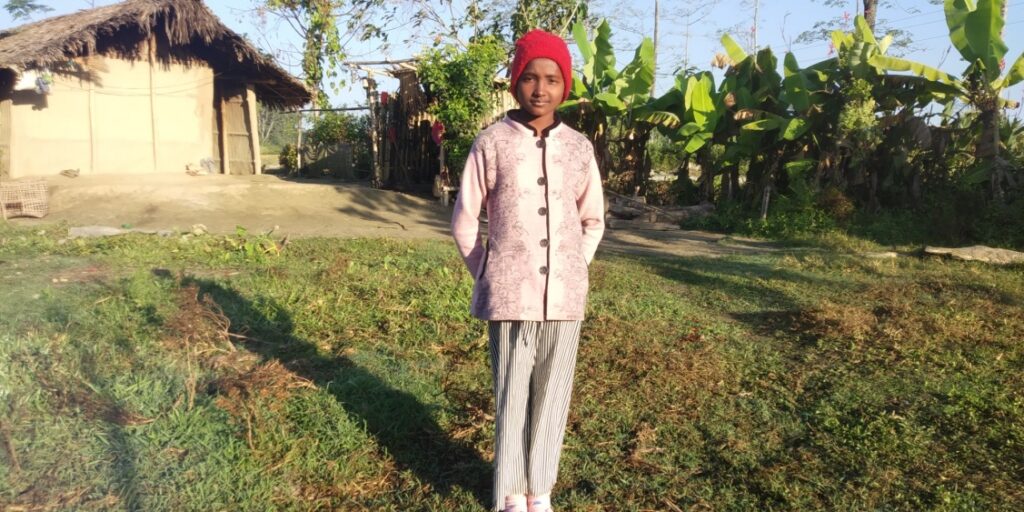
Mariam’s parents live in tents and move from place to place to search for work and wherever they go they take their three daughters among whom is Mariam. The three girls would then be left free and insecure while the parents were out for their work. Ever since she came here, she has shown signs of a great future, and she is intelligent as well. Mariam is now 10 years and reading in class II.
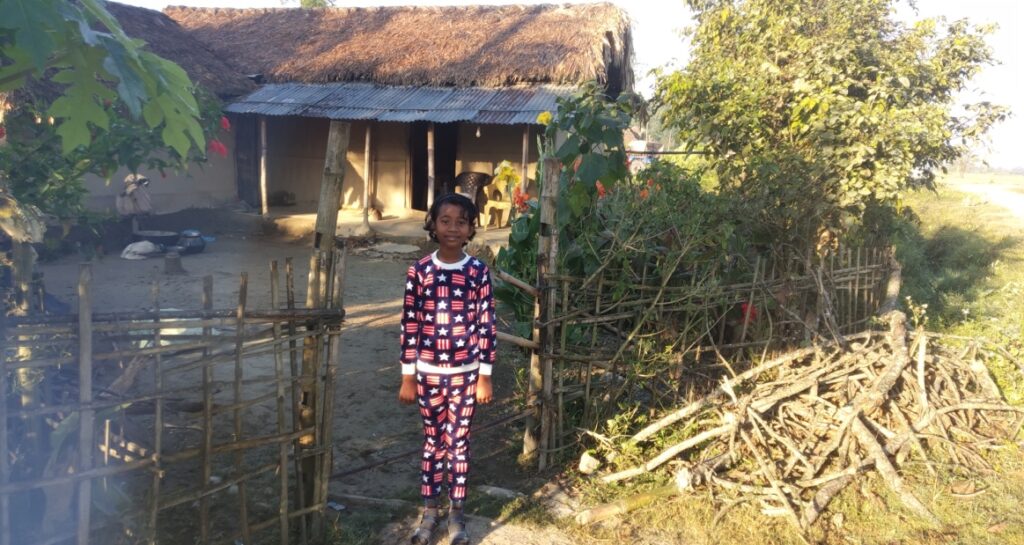
Salesian sisters came to Gandhinagar in 2019 with a dream to create a training centre for impoverished teenage girls. These are girls who are either poorly educated or have no education at all. Their parents are illiterate day labourers. A good number of the girls are being raised by single mothers, after the father either died or abandoned the family.
These girls are at a critical point in their lives. In this male-dominated society, the girls have little self-confidence and feel they have no control over their lives. They are led to believe they are second class, in fact are often told they were a “mistake” in families where male children are desired.
Without skills and vocational training, a girl will soon be either pregnant or vowed, usually to any man who the parents think can support her. There is a high level of alcohol abuse, even among the young; because of lack of opportunities, depression sets in, and suicide is sometime seen as the only way out of what is basically indentured servitude.
We are focusing on making the girls self-reliant through short-term training in various skills such as primary healthcare nursing, industrial sewing, and tech-support/information technology. The girls will receive enhanced English, DTP computer, and employability skills. They will learn advanced Excel with accounting, digital marketing, front office and back-office procedures, and graphic design. Placing the trained youth in jobs and following their progress for up to 6 months will also be part of this program.

What will this training achieve?
- Uplift poor and needy 15+ girls through education.
- Offer skill training and equip them for jobs.
- Ensure job placement.
- Instil self-confidence.
- Instil the knowledge that the girls have control over their lives.
- Enrich village life through these “change makers” who have succeeded.
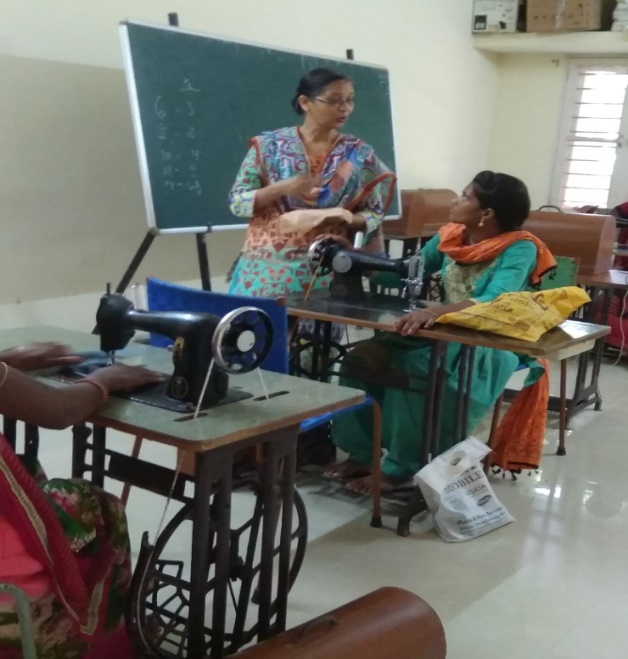
Outcomes
- Responsible and well-trained girls, who will then be responsible mothers.
- Gradual transformation of the person and of her extended family.
- Improved standard of living; the ability to save for the future.
- Later marriage and postponed forced pregnancy.
- Educated girls who will in turn value education for their children.
- Break the cycle of poverty.

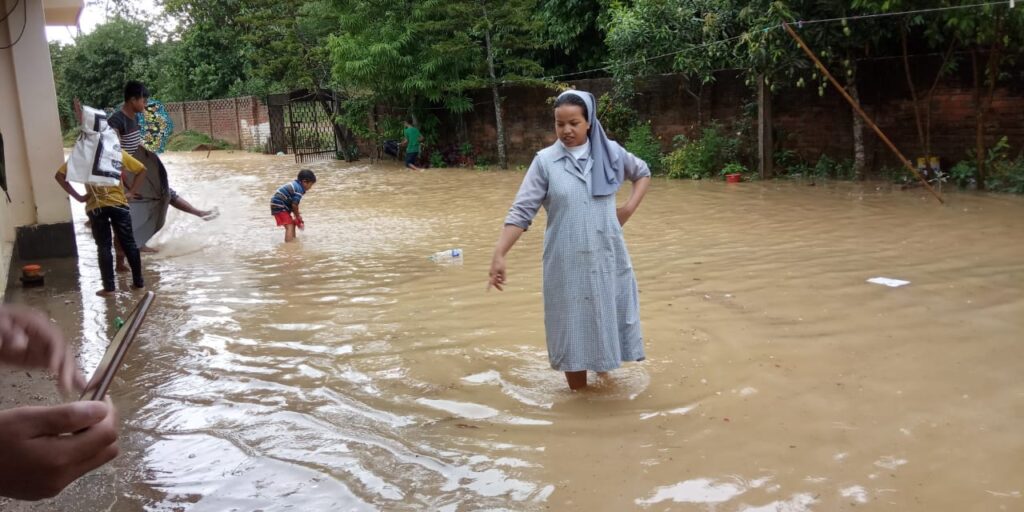
When the sisters at Mandwi, West Tripura sent us this photo, we knew we had to help. First, we had to locate West Tripura on the map! Although Homes of Hope representatives have been to many parts of India, this was a new one.
We found that West Tripura is nestled between Bangladesh and Manipur in India’s rugged Northeast. It is a very poor and undeveloped area, perfect for the sisters. They had a hostel – really a shed with a tin roof — but due to its location, it flooded with every major storm. Also, there are many children seeking admission, but there was no room. Our new Home of Hope will be home to 100 bright young girls.
Some of the girls who will be helped:
The children come from a tribal belt belonging to the different tribes like Debbarma, Reang, Rupini, Jamatia, Molsom, Hrangkhal, Munda, Chakma, Kaipeng, Tripura, etc. They are mostly first-generation learners and hence come from an educationally, socially economically backward region
Tanu and Remi Rupini are sisters, they are in the hostel, they come from a poor family, their mother died on 5th March 2023 due to kidney failure. Due to poverty, they have no possibility to go for better treatment, the mother was taking local medicines and from close by dispensary. Finally, the mother died, the father was with them. The maternal grandmother is taking care of their studies, and the sisters help them with hostel fees. They study in Don Bosco School Kairai Mandwi. They are good girls and clever in studies, Tanu is reading in class IX, Rimi is reading in class VII. They are ambitious and desire to go ahead in their studies.
Sonda Kaipeng comes from a poor family, the only child, her mother passed away when she was 2 years old. The father looks after her even though he has another wife. Sonda is a good girl, eager to learn and have a bright future. She is studying at Don Bosco School Kairai Mandwi. She is reading in class IX. She comes from an interior village which less facilities in education and transportation.
Anisha Tigga comes from a very poor family. She is the only child in the family. Her father left the family when she was small at the age of one year. Since then she has never seen her father. Her mother remains alone, poor in health. She is at home with her younger sister. Her uncle is helping her with her studies. She is reading in class XI, and she wants to join the Indian Army.

We were funding and building other projects, but we kept receiving emails and photos from a Salesian sister in the remote village of Veo in Arunachal Pradesh. As Sister Alphi explained:
We have constructed two halls for the children. We four sisters, along with children, stay in the same room. One hall we use as dormitory and other is used as study hall and a few are staying in the same room. Children in the dormitory stay together two in one bed. Some children sit on the floor and others stand to eat. We have no room.
It is so congested. Many agencies I approached but I didn’t get through.so finally I thought again seeking support from Home of Hope. I pray you may consider my humble request. Seeing the condition of the girl children I feel concerned to care and educate them. Otherwise, they become victims of many evil practices like child marriage, sexual abuse and become addicted drugs.
In this area they have the practice of taking young girls as their second wife. So, to protect from that old practices of this tribe we need to care for the girl children. The mothers feel insecure to keep girls alone at home even under the care of own sibling. We want to support and guide them, giving good faith formation and education but we are unable to give them support due to lack of facilities. Many parents have asked us to keep their children with us, but we do not have the space.
The villages are very far from Veo, and they must walk hours to reach the school. Some of the children are abused and live miserably in the family as servants. Some who are better off misuse the poor children who stay in their house and treat them as virtual slaves. Some of the poor parents even are forced to sell their children to rich people. So, we want these children to have a better life.
Looking at Sister Alphi’s sweet face and the adorable girl in her arms, could we resist helping? In 2024 we were finally able to see our way clear to fund Sister Alphi’s dream.
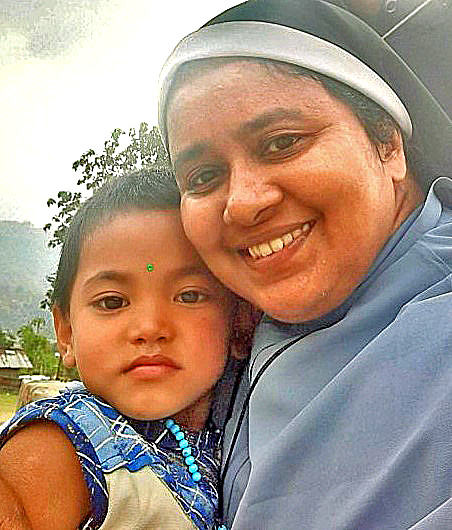
This map above is more than a map of India with a lot of dots.
- It is the story of rescue
from the horrors of the streets or villages
- It is the enkindling of hope
when hope seemed so far away
- It is the promise of a bright future
when all seemed lost
- It is the declaration of human dignity
when no one seemed to care
- It is all of us
working together
Our work in India began in 2006 focused on building a home for orphaned and abandoned girls. When it became clear that there were other children who needed our help, we did not hesitate to broaden our mission. So now, as we look at our map, we see the incredible diversity of our Homes of Hope.
Orphanages
- 1 Kochi
- 3 Secunderabad
- 6 Kokrajhar
- 7 Tangla
- 8 Bangalore
- 9 Mercy Home
- 13 Little Flower
- 14 Ethel Glazer Leo Home
AIDS orphanages
- 10 Chavara Home
- 11 Carmel Jyoti
- 21 Tengnoupal*
Orphanages, training centres
- 15 Khapmara
- 17 Khedpa
Differently-abled children
- 12 Alphonsa I
- 18 Archangel
Enslaved, marginalized girls
- 16 Mengio
- 20 Alphonsa II
Dalit/tribal hostels, training centres
- 19 Maria Nivaso*
- 24 Lengpui*
- 26 Lamabari
Hostels, training centres
- 4 Solabasti
- 25 Sulcorna
- 29 Holy Cross nurse hostel*
War orphan training centre
- 22 Vavuniya, Sri Lanka*
Sex-trafficked girls training centre
- 23 Belgaum
Schools
- 2 Maradiyur
- 5 Hassan
- 27 St. Joseph’s Guntur*
- 28 St. Joseph’s Dimapur*

